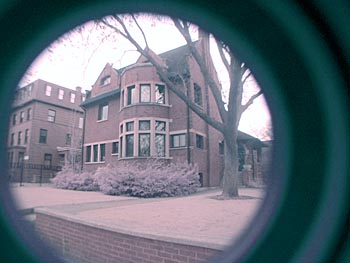I previously wrote up some experimentation with my Canon Powershot A95 in the near-infrared; those were done with a stock camera and two or three layers of fully-exposed and developed color negative film. Exposure times were horrendous, though, as the camera's internal IR-block filter fought against the external IR-pass filter. In broad daylight exposures were often 5-10 seconds long.
Anyways, I removed the IR filter from an old Canon S300 and here is an early image.

The IR filter is 2mm thick and in a converging light path--therefore it needs to be replaced or adjusted for; I didn't do that, and instead stuck a very concave lens (a 2x teleconverter) in front of the camera. It gets the nearsighted camera to focus at infinity, for some of the frame. I found that I could take the lens out of the housing of the teleconverter, and place it closer to the camera lens, which helped. I can zoom in just a bit and the focus is at infinity and a lot of the vignetting is gone.
No comments:
Post a Comment